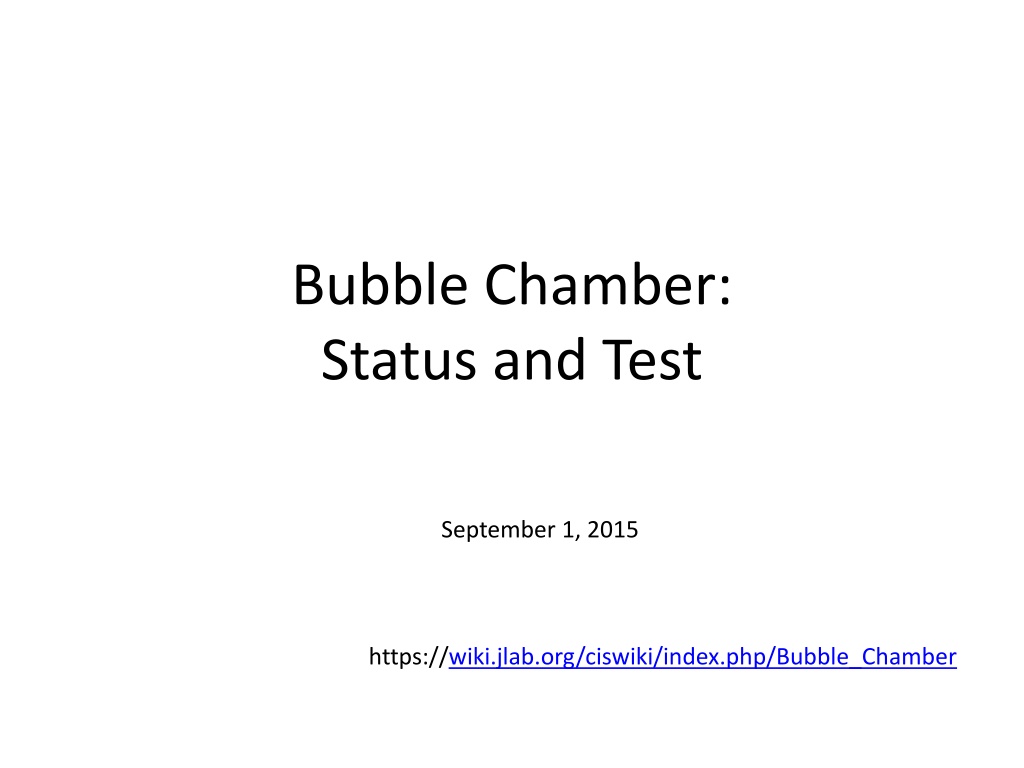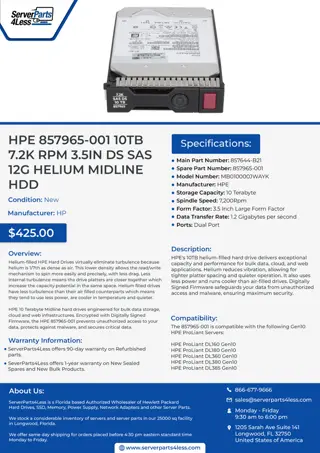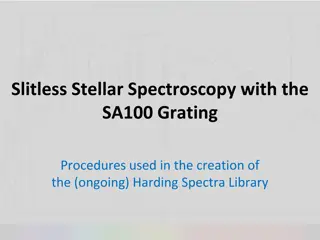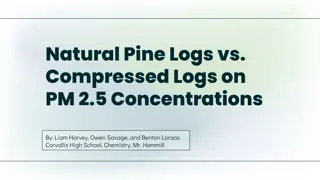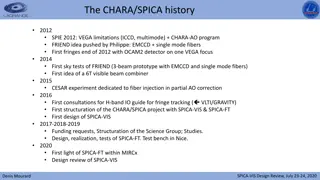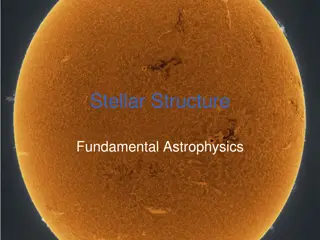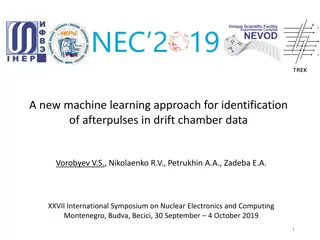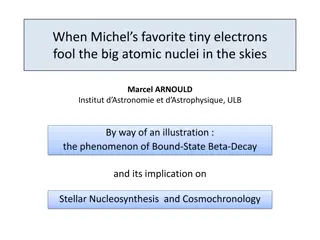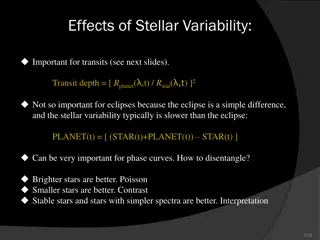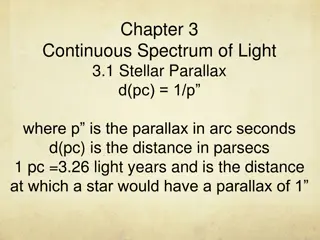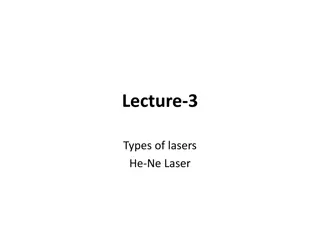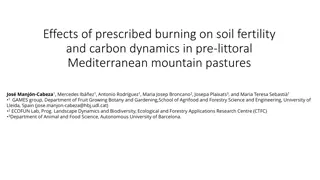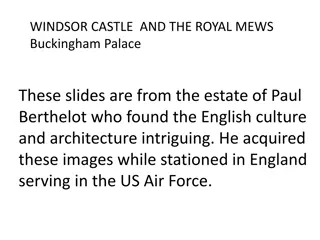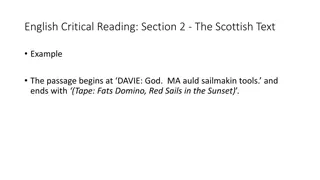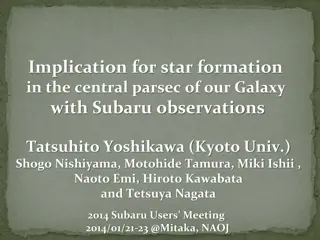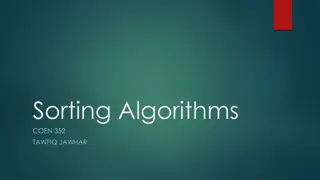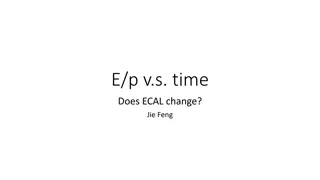Bubble Chamber: Nucleosynthesis and Stellar Helium Burning
Bubble chamber experiments and reactions related to nucleosynthesis, the 12C(,)16O reaction, and stellar helium burning are discussed. Details include electron beam requirements, cross section measurements, S-factor definitions, and experimental setups.
Download Presentation

Please find below an Image/Link to download the presentation.
The content on the website is provided AS IS for your information and personal use only. It may not be sold, licensed, or shared on other websites without obtaining consent from the author.If you encounter any issues during the download, it is possible that the publisher has removed the file from their server.
You are allowed to download the files provided on this website for personal or commercial use, subject to the condition that they are used lawfully. All files are the property of their respective owners.
The content on the website is provided AS IS for your information and personal use only. It may not be sold, licensed, or shared on other websites without obtaining consent from the author.
E N D
Presentation Transcript
Bubble Chamber: Status and Test September 1, 2015 https://wiki.jlab.org/ciswiki/index.php/Bubble_Chamber
Nucleosynthesis and 12C(,)16O Reaction Time Reversal Reaction: 16O( , )12C Bubble Chamber Electron Beam Requirements Bremsstrahlung Beam Penfold-Leiss Cross Section Unfolding JLab Projected Results Bubble Chamber Test Plans 2
(,) Stellar Helium burning The holy grail of nuclear astrophysics: Affects synthesis of most of elements in periodic table Sets N(12C)/N(16O) ( 0.4) ratio in universe Determines minimum mass star requires to become supernova 3
(,) Previous cross section measurements: Helium ions on carbon target: 12C( , )16O I. Carbon ions on helium gas: 4He(12C, )16O or 4He(12C,16O) (Sch rmann) II. Experiment Beam Current (mA) Target (nuclei/cm2) Time (h) 12C, 3 1018 Redder 0.7 900 12C, 5 1018 Ouellet 0.03 1950 4He, 1 1019 Roters 0.02 5000 12C, 3 1018 Kunz 0.5 700 12C, 1 1019 EUROGAM 0.34 2100 12C, 2 1018 GANDI 0.6 4He, 4 1017 Sch rmann 0.01 12C, 6 1018 Plag 0.005 278 4
(,) Define S-Factor to remove both 1/E dependence of nuclear cross sections and Coulomb barrier transmission probability: 2 ( , ) S E e CM m 2 1 12 = C Z Z 12 C 137 E CM Author Stot(300) (keV b) 162 39 Hammer (2005) Kunz (2001) 165 50 R-matrix Extrapolation to stellar helium burning at E = 300 keV 5
16O 12C 12 ( 12 ) ( ) M C M = = 2 2796 m c MeV 12 + C ( ) ( ) M C M = . 7 + 162 Q MeV CM+ E E Q 2 m c E CM 12 = ( ) ( ) C E E ( , ) ( , ) CM 2 E Stellar helium burning at E = 300 keV, T=200106 K 6
target signal beam + 16O 12C + Extra gain (factor of 100) by measuring time reversal reaction Bremsstrahlung at JLab ~ 109 /s (top 250 keV) Target density up to 104 higher than conventional targets. Number of 16O nuclei = 3.5 1022/cm2 (3.0 cm cell) Measures total cross section tot (or Stot=SE1 + SE2) Solid Angle and Detector Efficiency = 100% Electromagnetic debris (electrons and gammas, or positrons) do NOT trigger nucleation (detector is insensitive to -rays by at least 1 part in 1011) 7
1 Cell is cooled then filled with room temperature gas Critical point 1051 2 Gas is cooled and condenses into liquid Liquid 2 1 3 Once cell is completely filled with liquid, pressure is reduced creating a superheated liquid 3 Nuclear reactions induce bubble nucleation Vapor 3 309 2 High speed camera detects bubble and repressurizes 3 System depressurizes and ready for another cycle 8
T = -10C P = 50 atm 9
3.0 cm 100 Hz Digital Camera t = 10 ms N2O Chamber with PuC neutron source 11
I. Beam Properties at Radiator: Beam Kinetic Energy, (MeV) 7.9 8.5 Beam Current ( A) 0.01 100 Absolute Beam Energy Uncertainty <0.1% Relative Beam Energy Uncertainty <0.02% Energy Resolution (Spread), T /T Beam Size, x,y (mm) Polarization <0.06% 1 None 12
Use both GEANT4 and FLUKA to calculate Bremsstrahlung spectra (we will not measure Bremsstrahlung spectra) Monte Carlo simulation of Bremsstrahlung at radiotherapy energies is well studied, accuracy: 5% Bremsstrahlung Peaks 16O( )12C is ideal case for Bremsstrahlung beam and Penfold Leiss Unfolding: I. Very steep cross section; only photons near endpoint contribute to yield II. No-structure (resonances) 13
Measure yields at: ? = ?1,?2,,?? where, ?? ??1= , ? = 2,? = th i i dk k k E n E Y ) ( ) , ( ) ( i E = j i ( , , ) ( ) N E E E i j j 1 Method of Quadratures: numerical solution of integral equation based on replacement of integral by finite sum Volterra Integral Equation of First Kind Solution can be written in two forms: ( ) 1 1 i = j = y N i i ij j N 1 ii Or, Matrix form: = N Y N = Y 0 0 N y 11 , 1 1 0 N N y , 21 , 22 2 2 = 0 1 N N N y , 1 , 2 , n n nn n n 14
Electron Beam K. E. Cross Stat Error (no bg, %) Stat Error (with bg, %) Section (nb) 7.9 0.046 4.4 24.5 8.0 0.185 6.0 20.7 8.1 0.58 6.3 14.7 8.2 1.53 8.2 13.8 8.3 3.49 9.1 13.3 8.4 7.2 10.6 13.8 8.5 13.6 12.2 14.8 Electron Beam K. E. Cross Sys Error (Energy, %) Sys Error (Total, %) Absolute Beam Energy, E 0.1% Section (nb) Beam Current, I/I 3% 7.9 0.046 12.5 15.3 8.0 0.185 10.2 13.5 Photon Flux, / 5% 8.1 0.58 8.3 12.2 8.2 1.53 7.0 11.4 Radiator Thickness, R/R 3% 8.3 3.49 6.0 10.7 Bubble Chamber Thickness, T/T 3% 8.4 7.2 5.3 10.5 8.5 13.6 4.7 10.1 Bubble Chamber Efficiency, 5% 15
(,) Statistical Error: dominated by background subtraction from 18O( , )14C (depletion = 5,000) Electron Beam K. E. Energy (MeV) (MeV) Gamma ECM Cross Section (nb) Stot Factor (keV b) Stat Error (%) Sys Error (Total, %) 7.9 7.85 0.69 0.046 62.2 24.5 15.3 8.0 7.95 0.79 0.185 48.7 20.7 13.5 8.1 8.05 0.89 0.58 41.8 14.7 12.2 8.2 8.15 0.99 1.53 35.5 13.8 11.4 8.3 8.25 1.09 3.49 32.0 13.3 10.7 8.4 8.35 1.19 7.2 28.8 13.8 10.5 8.5 8.45 1.29 13.6 26.3 14.8 10.1 Bubble Chamber experiment measures total S-Factor, SE1 + SE2 16
Total S-Factor ~ SE1 (SE2 is small) 17
Power deposited in radiator (100 A and 8.5 MeV) : I. 6 mm: Energy loss = 8.5 MeV, P = 850 W Pure Copper and Aluminum (high neutron threshold): I. II. 63C( ,n) threshold = 10.86 MeV 27Al( ,n) threshold = 13.06 MeV Electron K.E. 7.9 8.5 MeV 0.01 100 A Cu Radiator/Dump 6 mm Al Beam Pipe Cu Photon Collimator Ceramic Insulator Al Photon Dump 40 cm long Bubble Chamber Superheated N2O 3 cm long -10 C, 50 atm 19
Bubble Chamber location 5 MeV Dipole 5D Spectrometer 20
Cu Electron Radiator/Dump Al Photon Dump Cu Photon Collimator 21
5 MeV Dipole Installed new higher field dipole with better uniformity Installed new Hall probe: 0.01% accuracy, resolution to 2 ppm, and a temperature stability of 10 ppm/ C Beam Position Monitor (BPM) Still need to shield Earth s and other stray magnetic fields Bdl = Electron Beam Momentum p 23
Beamline was ready since Fall 2014 Approved to run 10 A CW and total energy of 10 MeV Completed hot checkout and beam checkout Beam Studies completed so far: I. Delivered 10.0 A and 9.65 MeV (kinetic) for 5 hours in August 2015 II. Measured beam momentum at different cryo-unit settings III. Measured beam charge at different beam currents Re-doing realistic thermal analysis to run at 100 A 24
1. Fill with natural N2O test bubble chamber systems operation 2. With beam on bubble chamber radiator (Sept 8 18, 2015): I. II. Count rates on bubble chamber. Do we get single or multiple bubbles from Bremsstrahlung beam exposure? III. Measure gamma ray beam spatial profile as reflected by bubble distribution. Is collimator effective in defining the gamma-ray beam? How does CCD camera perform under beam-on conditions? 3. Background measurements: I. II. Measure beam on background by looking outside fiducial volume III. Measure background with beam to Faraday Cup in CEBAF beamline (about two meters from chamber) IV. Measure neutron events in chamber. Neutron radiation detectors in injector region will indicate if any neutrons are generated (especially at beam kinetic energies higher than 8.5 MeV). Measure beam off environmental background in chamber-injector area 25
4. Fill with C2F6 test bubble chamber systems operation. This is planned later in September after first beam test. 5. With beam (planned in Oct 16 22, 2015) Measure few data points of from 19F( , )15N (Q = +4.013 MeV) to perform a Penfold-Leiss unfolding II. Compare measured cross section to our HIGS data I. Fluorine is suitable for a first Penfold-Leiss unfolding: Only one stable natural isotope (19F) Low electron beam kinetic energy (4.6 5.2 MeV) below threshold of any background reaction Can we measure a cross section below our limit at HIGS of 3 nb? 26
Superheated liquid: N2O, Nitrous oxide (laughing gas) I. Colorless, non-flammable gas, with slightly sweet odor and taste 0 High pressure system: I. Design Authority: Dave Meekins II. T = -10 C III. P = 50 atm 0 2 OX Buffer liquid: Mercury I. Closed system II. Volume: 150 mL 0 0 3 Bubble Chamber Safety Review was on Aug 18, 2015 Temporary Operational Safety Procedures (TOSP) is approved 27
19F( )15N 29
Electron Beam Energy: 400 MeV Electron Beam Current: 41 mA Interaction Length: 35 m Vacuum: 2x10-10 Torr Residual Gas: Z = 10 Strong Bremsstrahlung Background (when coupled with large cross sections at high energies) 30
I. List of superheated liquids to be used in experiment: 16O 17O 18O N2O Targets Natural Target 99.757% 0.038% 0.205% Physics 16O Target Depleted > 5,000 Depleted > 5,000 17O Target Enriched > 80% <1.0% Measure Backgrounds 18O Target <1.0% Enriched > 80% II. Readout: I. Fast Digital Camera II. Acoustic Signal to discriminate between neutron and alpha events 31
